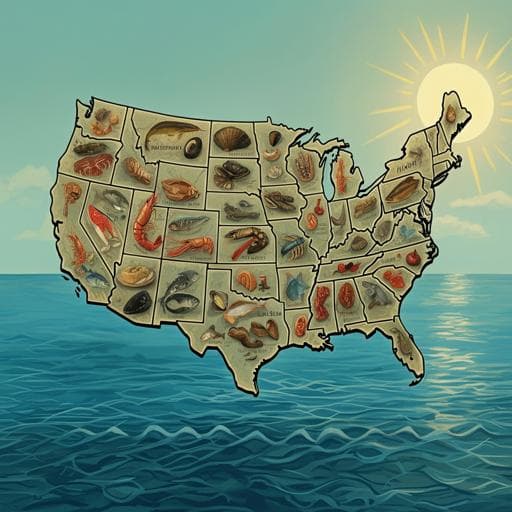
Environmental Studies and Forestry
Seafood independence is within reach: a multi-scale assessment of seafood self-reliance in the United States
T. S. Oyikeke, S. Advani, et al.
This study by Tolulope Samuel Oyikeke, Sahir Advani, and Joshua Scott Stoll explores the potential for seafood self-reliance in the U.S. by analyzing comprehensive data from 1970 to 2021. It reveals that while the country is heavily dependent on seafood imports, a national-level self-reliance is within reach through shifts in consumer behavior and investment in infrastructure.
~3 min • Beginner • English
Introduction
Food insecurity and diet-related disease are major health challenges in the United States, disproportionately affecting rural and historically marginalized communities. While blue foods (marine and aquatic foods) are recognized for high nutritional value and are recommended in U.S. dietary guidelines (≥8 oz/week), their contributions to U.S. food system transformation are often overlooked (e.g., not highlighted in the White House National Strategy on Hunger, Nutrition, and Health). The U.S. imports an estimated 80% of seafood consumed by volume, yet also produces substantial quantities (8.4 billion pounds in 2020). This study asks whether U.S. blue food production can meet domestic demand—both current consumption and a healthy-diet scenario—and thus achieve seafood independence (meeting seafood needs from domestic production, reducing reliance on imports). The authors evaluate regional and national self-reliance over 1970–2021 to inform efforts to address food and nutrition insecurity and align with the 2023 National Seafood Strategy.
Literature Review
Prior work has quantified the share of U.S. seafood consumption that is imported and emphasized the need for better accounting of seafood trade flows. The COVID-19 pandemic exposed vulnerabilities from heavy reliance on global trade and prompted calls to strengthen domestic seafood supply chains. However, no prior analysis has systematically evaluated the potential for the U.S. to achieve seafood independence or to meet dietary recommendations through domestic production across regions and time. Studies of regional food self-sufficiency (e.g., New England, Northeast) provide context but do not provide a comprehensive, national, multi-decadal seafood self-reliance assessment.
Methodology
Design: A self-reliance analysis was conducted at regional (seven U.S. Regional Fishery Management Council regions) and national scales over 1970–2021, integrating production (commercial landings), edible yield, utilization, and consumption. Categories analyzed were fish, shellfish, and “other species.”
Data sources: NOAA Fisheries annual commercial landings (1970–2021) in round (live) weight and value for all species (excluding territorial landings and landings by U.S.-flag vessels at ports outside the 50 states). Mollusk landings were reported as meat weight. Consumption and availability data were obtained from USDA ERS (1970–2018) and NOAA Fisheries (2019–2021).
Data preparation and assumptions: Confidential landings were imputed using historical averages and corroborated with NOAA annual reports; in some cases, state-specific data were used. Species names were harmonized to market or species group names. Only species intended for human consumption in each region were retained; species primarily used as bait or non-food were excluded. Edible portions were applied via species-specific edible proportion factors to convert landed weights to edible weight. Data were grouped into fish, shellfish, and other species. Analyses were performed in R (v4.2.2) in RStudio.
Regional classification: States were grouped into seven regions following U.S. Regional Fishery Management Council boundaries. Of 30 states with landings data, 24 were assigned to regions; six inland states (Illinois, Indiana, Michigan, Minnesota, Ohio, Wisconsin) were grouped as “Other States.” Hawaii (Western Pacific) began reporting landings in 1981.
Production estimation: For each species and year, edible weight was calculated by multiplying landings by its edible proportion. Annual totals were summed across species and grouped by category and region; national production was the aggregate across all seafood-producing states.
Consumption estimation: National per capita availability (ERS/NOAA) was regrouped into fish (fresh/frozen fish; canned salmon, sardines, tuna), shellfish (fresh/frozen and canned shellfish), and other species. Regional consumption for each category and year was estimated by multiplying national per capita availability by regional population; national consumption by multiplying national per capita availability by national population. USDA’s population includes the 50 states and D.C., excluding territories. Regional populations were aggregated from constituent states.
Self-reliance metrics: Regional self-reliance (RSR) and national self-reliance (NSR) were computed as production divided by consumption for each category and year, expressed as a percentage. Species used as bait, non-food uses, and confidentiality considerations were explicitly handled in estimates.
Key Findings
- Production trends (1970–2021): National edible seafood production increased over decades, with a sharp mid-1980s rise due to pollock expansion in Alaska; growth slowed in the 2000s–2010s, stabilizing at ~3.4 million metric tons. Alaska (North Pacific) disproportionately drives national production. Only Alaska, New England, and Hawaii showed increased or stable production in the last two decades; other regions trended downward.
- Regional self-reliance (RSR):
• Fish: Alaska had the highest RSR with a 1970–2021 annual mean of ~27,000%; Hawaii 119%; New England 99%; Pacific (West Coast) 80%; South Atlantic 14%; Gulf of Mexico 11%; Mid-Atlantic 7%. West Coast declined from 142% (1970) to 27% (2021). Alaska rose from ~6,000% (1970s) to ~40,000% (1995), stabilizing until 2017, then 27,000% (2021). New England peaked at 175% (1982), declining to 36% (2021). Other regions remained low and stable.
• Shellfish: General downward RSR trends from 1972 in South Atlantic, Mid-Atlantic, Gulf of Mexico, Pacific (West Coast), Hawaii, and Alaska; Hawaii recorded the lowest shellfish RSR in 2021. Mid-Atlantic and Gulf of Mexico reached their lowest RSR in 2020 and 2021, respectively. New England maintained relatively high shellfish RSR with a 1970–2021 mean of 105%.
• Other species: Highest mean RSRs (1970–2021) in Pacific (West Coast) 9,533%, Alaska 4,148%, Mid-Atlantic 1,899%, New England 1,059%; lowest in Gulf of Mexico 105%, South Atlantic 44%, Hawaii 30%. Upward trends from 1996 to ~2000 were largely driven by squid production.
- National self-reliance (NSR):
• Shellfish NSR declined from 68% (1970) to 15% (2021); mean 42%.
• Fish NSR increased from 49% (1970) to peaks of 125% (1992) and 128% (2013); averaged ~110% (1993–2013); declined to 73% (2021).
• Other species NSR was very high (in the thousands), peaking at 9,465% (1993), declining to 713% (2019), then 918% (2021).
• Decadal mean overall NSR (all categories combined): 59% (1972–1981), 70% (1982–1991), 98% (1992–2001), 81% (2002–2011), 76% (2012–2021).
- Consumption: Total per capita seafood consumption rose from 11.7 lb (1970) to 20.3 lb (2021), driven primarily by shellfish (from 2.9 lb in 1970 to 7.2 lb in 2021). Fish per capita reached 12 lb in 2021 after dipping to 8.7 lb in 2018. Other species rose slightly to 1.1 lb (2021). Current consumption is ~78% of the recommended 26.07 lb per capita per year.
- Contextual figures: Despite importing ~80% of consumed seafood by volume (~6.1 billion lb), the U.S. produced ~8.4 billion lb in 2020 and is among the world’s largest producers. U.S. population grew from ~201 to ~350 million over the study period.
Discussion
The analysis shows U.S. seafood self-reliance varies by category and region. National self-reliance for fish has generally exceeded 70% since 1990, while shellfish self-reliance has declined to ~15% by 2021. These patterns reflect consumption-production dynamics: shellfish consumption growth has outpaced domestic production since the late 1980s, whereas fish consumption declined until 2018 and then increased, contributing to a recent NSR decline. Aggregating categories, national self-reliance has ranged from roughly half to fully self-reliant (49%–110%) over 50 years, peaking in the 1990s, and averaging 76% in the most recent decade, indicating that seafood independence is within reach under current consumption levels. Alaska’s outsized contribution (about two-thirds of U.S. harvest, led by pollock, cod, salmon) strongly influences national totals. Regional differences arise from species composition (e.g., exclusion of bait species from edible analysis), regulatory histories, ecosystem productivity, population size, and consumption patterns. Although current U.S. markets import most seafood consumed, the production potential evidenced by high NSR in fish and other species categories suggests domestic blue foods could substantively meet demand if supply chains and consumer demand were aligned. When benchmarked against dietary recommendations, national consumption remains below recommended levels (78% of target), implying that even if the U.S. can approach self-reliance at current consumption, domestic production would need to expand or shift to meet a fully health-aligned consumption scenario, especially for shellfish.
Conclusion
This study demonstrates that the United States could achieve high levels of seafood self-reliance nationally—approaching or exceeding 100% under current consumption—despite heavy import dependence, with Alaska playing a pivotal role. However, domestic production currently falls short of supporting nationwide adherence to recommended seafood intake, particularly for shellfish. Advancing seafood independence and health outcomes will require: (1) shifting consumer preferences toward domestically available and underutilized species (including those now used as bait or exported), with enhanced access for historically marginalized communities; (2) investing in infrastructure across the supply chain (working waterfronts, cold storage, processing, and regional distribution) designed for local and regional markets rather than global export; (3) expanding mariculture strategically to meet rising shellfish demand; and (4) adapting to climate change impacts on production. Future research should refine regional dietary alignment strategies, evaluate infrastructure and policy interventions, incorporate climate-informed production scenarios, and improve accounting of trade flows and utilization to support evidence-based pathways to seafood independence.
Limitations
- Consumption estimates rely on national per capita availability applied to regional populations, which may not fully reflect regional dietary preferences or intra-regional distribution.
- Landings classified as confidential were imputed using historical averages and ancillary reports, introducing estimation uncertainty.
- Species primarily used as bait or non-food were excluded, potentially underestimating re-directable edible resources if markets change.
- Landings by U.S.-flag vessels at ports outside the 50 states and U.S. territories were excluded; USDA availability population excludes territories; Hawaii data begin in 1981.
- Six inland states were grouped as “Other States,” and not assigned to the seven council regions, which may affect regional aggregation.
- Edible portion conversion factors and species grouping (fish, shellfish, other) introduce categorization assumptions.
- The analysis focuses on production and availability, not economic feasibility, price effects, or detailed trade logistics necessary to reorient supply chains.
Related Publications
Explore these studies to deepen your understanding of the subject.







